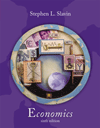 |
1 |  | 
A good or service produced by an oligopolist |
|  | A) | must be differentiated. |
|  | B) | must be identical. |
|  | C) | may be identical or differentiated. |
 |
 |
2 |  | 
Statement I. An oligopolized industry may not have more than four firms. Statement II. Most
oligopolized industries have concentration ratios of 100. |
|  | A) | Statement I is true and statement II is false. |
|  | B) | Statement II is true and statement I is false. |
|  | C) | Both statements are true. |
|  | D) | Both statements are false. |
 |
 |
3 |  | 
Which is the most accurate statement? |
|  | A) | The automobile industry is an oligopoly. |
|  | B) | In an oligopolized industry, all firms make substantial profits. |
|  | C) | Oligopolized industries consist only of large firms. |
|  | D) | Oligopolies often charge lower prices than would perfect competitors. |
 |
 |
4 |  | 
Statement I. The more firms in an industry, the higher its concentration ratio. Statement II. Most
firms in the U.S. are oligopolies. |
|  | A) | Statement I is true and statement II is false. |
|  | B) | Statement II is true and statement I is false. |
|  | C) | Both statements are true. |
|  | D) | Both statements are false. |
 |
 |
5 |  | 
Which statement is the most accurate? |
|  | A) | Virtually all sectors of the American economy are highly competitive. |
|  | B) | Most American industries have a concentration ratio within the range of 90 and 100. |
|  | C) | There is no consensus as to the degree of competitiveness of much of the American economy. |
 |
 |
6 |  | 
Statement I. The TV networks could not be considered oligopolies. Statement II. A firm with a
kinked demand curve is highly competitive. |
|  | A) | Statement I is true and statement II is false. |
|  | B) | Statement II is true and statement I is false. |
|  | C) | Both statements are true. |
|  | D) | Both statements are false. |
 |
 |
7 |  | 
A firm that had a monopoly would have a Herfindahl-Hirschman index of |
|  | A) | 100. |
|  | B) | 1,000. |
|  | C) | 10,000. |
|  | D) | 100,000. |
|  | E) | 1,000,000. |
 |
 |
8 |  | 
A very oligopolistic industry would have a relatively _____ concentration ratio and a relatively ____ Herfindahl-Hirschman index. |
|  | A) | high, high |
|  | B) | low, low |
|  | C) | high, low |
|  | D) | low, high |
 |
 |
9 |  | 
The least competitive of the following is |
|  | A) | open collusion. |
|  | B) | covert collusion. |
|  | C) | a cartel. |
|  | D) | price leadership. |
 |
 |
10 |  | 
OPEC is an example of |
|  | A) | open collusion. |
|  | B) | covert collusion. |
|  | C) | a cartel. |
|  | D) | price leadership. |
 |
 |
11 |  | 
Each of the following companies was found guilty of price-fixing except |
|  | A) | Archer Daniels Midland. |
|  | B) | Roche Holding A.G. |
|  | C) | the Ford Motor Company. |
|  | D) | BASF A.G. |
 |
 |
12 |  | 
Cutthroat competition is most closely associated with |
|  | A) | covert competition. |
|  | B) | the kinked demand curve. |
|  | C) | constant price changes. |
|  | D) | OPEC. |
 |
 |
13 |  | 
When a firm with a kinked demand curve raises its price, its competitors |
|  | A) | will raise theirs. |
|  | B) | lower theirs. |
|  | C) | keep theirs unchanged. |
 |
 |
14 |  | 
An oligopolist will charge a _______ price than a perfect competitor and will operate _______
efficiently than a perfect competitor. |
|  | A) | higher, less |
|  | B) | higher, more |
|  | C) | lower, less |
|  | D) | lower, more |
 |
 |
15 |  | 
When an oligopolist operates with a kinked demand curve, she will operate at an output |
|  | A) | less than at the kink. |
|  | B) | at the kink. |
|  | C) | more than at the kink. |
 |



 2002 McGraw-Hill Higher Education
2002 McGraw-Hill Higher Education

 2002 McGraw-Hill Higher Education
2002 McGraw-Hill Higher Education